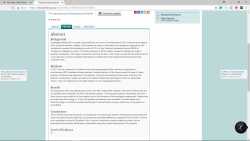19th September 2018
Check out this video review by the author himself, Dr. Tytgat from Wilhelmina Children’s Hospital in Utrecht, Netherlands!
He discusses their experience with selective THORACOSCOPIC POSTERIOR TRACHEOPEXY in patients with intraoperatively diagnosed posterior tracheomalacia, DURING primary ESOPHAGEAL ATRESIA REPAIR.
They found the patients had no respiratory symptoms 6 months postoperatively and had no post-operative complications.
Paper link below
Link: http://ow.ly/8Lpw30lT7Yn
Posterior Tracheopexy during primary esophageal repair
Check out this video review by the author himself, Dr. Tytgat from Wilhelmina Children’s Hospital in Utrecht, Netherlands! He discusses their experience with selective THORACOSCOPIC POSTERIOR TRACHEOPEXY in patients with intraoperatively diagnosed posterior tracheomalacia, DURING primary ESOPHAGEAL ATRESIA REPAIR. They found the patients had no respiratory symptoms 6 months post-operatively and had no post-operative complications.Link: http://ow.ly/8Lpw30lT7YnIs this prophylactic treatment of tracheomalacia or an unnecessary procedure? Let us know what you think!Video edited by Rae Hanke at Cincinatti Childrens Hospital
تم النشر بواسطة Journal of Pediatric Surgery في الأربعاء، ١٩ سبتمبر ٢٠١٨
September 06, 2018
The authors assessed the efficacy of high-dose esomeprazole and aspirin to improve the outcomes of patients with Barrett’s esophagus. Patients were assigned to low-dose esomeprazole without aspirin, high-dose esomeprazole without aspirin, low-dose esomeprazole with aspirin, and high-dose esomeprazole with aspirin.
High-dose esomeprazole was superior to low-dose esomeprazole, but treatment with aspirin was not significantly better than without. However, combining high-dose esomeprazole with aspirin had the strongest effect on outcomes compared with low-dose esomeprazole without aspirin.
BACKGROUND
Oesophageal adenocarcinoma is the sixth most common cause of cancer death worldwide and Barrett’s oesophagus is the biggest risk factor. We aimed to evaluate the efficacy of high-dose esomeprazole proton-pump inhibitor (PPI) and aspirin for improving outcomes in patients with Barrett’s oesophagus.
To Read More Click on the banner link
Ea-Tef – Esophageal Atresia/Tracheoesophageal Fistula Research Studies Plus Barrett’s Esophagus
August 22, 2018
The authors conducted this prospective multicenter cohort study to examine single-use transnasal capsule endoscopy for the detection of Barrett’s esophagus. A total of 178 patients (of whom 94 [53%] had Barrett’s esophagus) underwent either the transnasal capsule endoscopy or upper endoscopy (EGD) on the same day. Overall, the transnasal capsule endoscopy had a sensitivity and specificity of 0.90 and 0.91, respectively, in detecting Barrett’s esophagus with a higher sensitivity/specificity for long-segment Barrett’s. The capsule endoscopy group overall tolerated the procedure better than the EGD group, and had a higher preference level (54.2% vs 16.7%; P<.001). No serious adverse events occurred.
The clinic-based transnasal capsule endoscopy represents a feasible, safe, and acceptable method of screening for Barrett’s esophagus, but had a relatively low technical success rate.
Ea-Tef – Esophageal Atresia/Tracheoesophageal Fistula Research Studies Plus Barrett’s Esophagus
Jan. 23, 2018
Helen R. Moinova, Ph.D., from the Case Western Reserve University in Cleveland, and colleagues developed a well-tolerated swallowable, encapsulated balloon device that was able to selectively sample the distal esophagus within five minutes, and was further engineered to progress toward non-endoscopic esophageal screening. The authors had ascertained regions targeted for recurrent aberrant cytosine methylation in BE with genome-wide screening, identifying high-frequency methylation within the CCNA1 locus. CCNA1 DNA methylation was assessed as a BE biomarker in cytology brushings of the distal esophagus from 173 individuals with or without BE.
Ea-Tef – Esophageal Atresia/Tracheoesophageal Fistula Research Studies Plus Barrett’s Esophagus
06 April 2018
Volumetric laser endomicroscopy (VLE) is used to identify Barrett’s esophagus (BE) dysplasia. Selection of a dysplastic region of interest (ROI) can be challenging due to feature variability across a large amount of data. The degree of agreement among VLE users in selecting a ROI has not been studied.
High‐definition videos that divided a VLE scan from 18 patients with biopsy‐proven BE dysplasia into 1‐cm segments were reviewed using a four‐quadrant grid superimposed for systematic interpretation. VLE scans were selected based on image quality and appropriate visualization of BE epithelium.
Ea-Tef – Esophageal Atresia/Tracheoesophageal Fistula Research Studies Plus Barrett’s Esophagus
August 08, 2018
The authors examined associations between gastrointestinal symptoms and gas production after sugar provocation tests in patients with functional gastrointestinal disorders (FGID) to uncover mechanisms of FGID. Multiple clusters of gastrointestinal symptoms, central nervous system (CNS) symptoms, and hydrogen and/or methane breath concentrations were identified after fermentable sugar ingestion. Hydrogen and methane gas production only correlated with GI symptoms, whereas GI and CNS symptoms correlated with the sugar intake.
Clusters of GI and CNS symptoms were associated with sugar ingestion, and breath gas concentrations were associated with specific GI symptoms. The authors concluded that these results suggest that there are distinct mechanisms for pathogenesis of different FGIDs such as microbial dysbiosis, chemical sensitization, and mechanical sensitization.
Ea-Tef – Esophageal Atresia/Tracheoesophageal Fistula Research Studies Plus Barrett’s Esophagus
Ea-Tef – Esophageal Atresia/Tracheoesophageal Fistula Research Studies Plus Barrett’s Esophagus
July 04, 2018
Fully covered self-expanding metal stents were compared with partially covered self-expanding metal stents for treatment of patients with malignant esophageal strictures during a median follow-up of 54 days in this multicenter, randomized controlled trial. There was no difference between the two stents in terms of recurrent obstruction, including stent migration or time to recurrent obstruction. There was also no difference in major adverse events between the two stents. The multivariable analysis did not reveal any significant risk factors for recurrent obstruction.
There was no difference in the rate of recurrent obstruction between fully-covered and partially-covered self-expanding metal stents in the treatment of malignant esophageal strictures.

